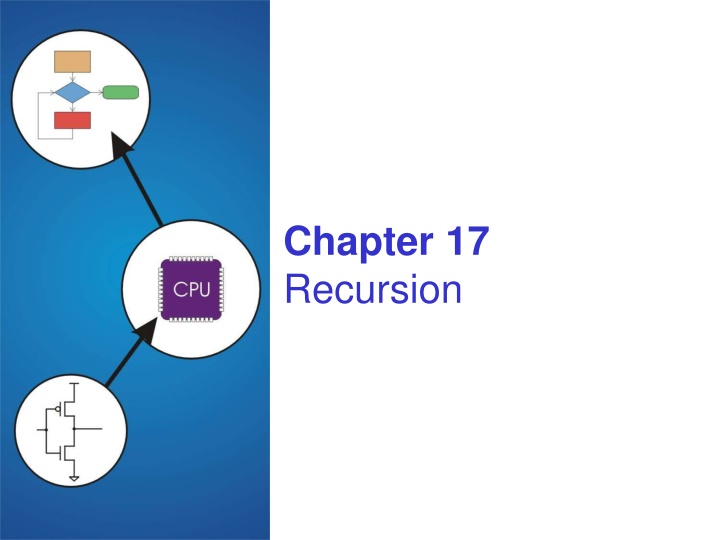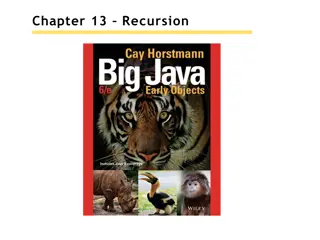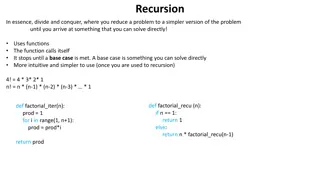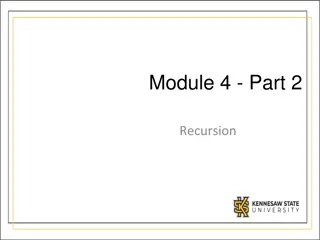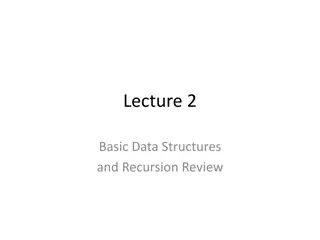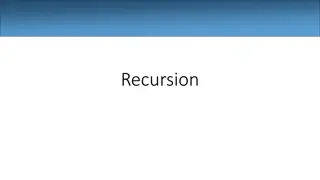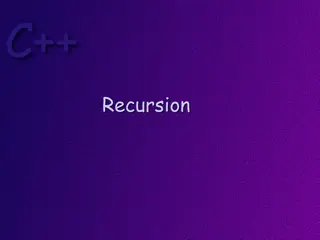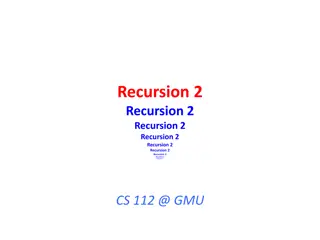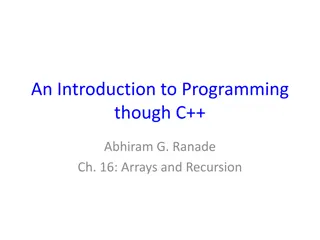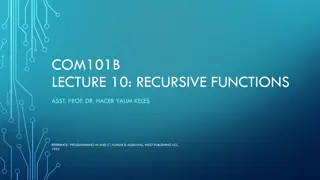Recursion in Programming: Solving Tasks by Calling Itself
Recursion, a fundamental concept in programming, involves solving tasks by calling the function itself on smaller data. This method, similar to recurrence function in mathematics, offers a simpler solution in many scenarios. With examples like the running sum and binary search, recursion illustrates its efficiency in problem-solving. The Fibonacci sequence, an intricate mathematical pattern, further demonstrates the power of recursion in generating numbers. Dive into the world of recursion and enhance your coding skills with this comprehensive guide.
Download Presentation

Please find below an Image/Link to download the presentation.
The content on the website is provided AS IS for your information and personal use only. It may not be sold, licensed, or shared on other websites without obtaining consent from the author.If you encounter any issues during the download, it is possible that the publisher has removed the file from their server.
You are allowed to download the files provided on this website for personal or commercial use, subject to the condition that they are used lawfully. All files are the property of their respective owners.
The content on the website is provided AS IS for your information and personal use only. It may not be sold, licensed, or shared on other websites without obtaining consent from the author.
E N D
Presentation Transcript
Chapter 17 Recursion
What is Recursion? A recursive function is one that solves its task by calling itself on smaller pieces of data. Similar to recurrence function in mathematics. Like iteration -- can be used interchangeably; sometimes recursion results in a simpler solution. n 1 i Example: Running sum ( ) Mathematical Definition: RunningSum(1) = 1 RunningSum(n) = n + RunningSum(n-1) Recursive Function: int RunningSum(int n) { if (n == 1) return 1; else return n + RunningSum(n-1); } 17-2
Executing RunningSum res = RunningSum(4); RunningSum(4) return value = 10 return 4 + RunningSum(3); RunningSum(3) return value = 6 return 3 + RunningSum(2); RunningSum(2) return value = 3 return 2 + RunningSum(1); RunningSum(1) return value = 1 return 1; 17-3
High-Level Example: Binary Search Given a sorted set of exams, in alphabetical order, find the exam for a particular student. 1. Look at the exam halfway through the pile. 2. If it matches the name, we're done; if it does not match, then... 3a. If the name is greater (alphabetically), then search the upper half of the stack. 3b. If the name is less than the halfway point, then search the lower half of the stack. 17-4
Binary Search: Pseudocode Pseudocode is a way to describe algorithms without completely coding them in C. FindExam(studentName, start, end) { halfwayPoint = (end + start)/2; if (end < start) ExamNotFound(); /* exam not in stack */ else if (studentName == NameOfExam(halfwayPoint)) ExamFound(halfwayPoint); /* found exam! */ else if (studentName < NameOfExam(halfwayPoint)) /* search lower half */ FindExam(studentName, start, halfwayPoint - 1); else /* search upper half */ FindExam(studentName, halfwayPoint + 1, end); } 17-5
Detailed Example: Fibonacci Numbers Mathematical Definition: ) 1 ( ) ( = f = + f n f n f ( n ) 2 ) 1 ( f 1 = ( 0 ) 1 In other words, the n-th Fibonacci number is the sum of the previous two Fibonacci numbers. 17-10
Fibonacci: C Code int Fibonacci(int n) { if ((n == 0) || (n == 1)) return 1; else return Fibonacci(n-1) + Fibonacci(n-2); } 17-11
Activation Records Whenever a function is invoked, a new activation record is pushed onto the stack. main calls Fibonacci(3) Stack grows from higher to lower addresses. The stack pointer SP points to the last filled location. R6 Fib(3) In LC3, R6 serves as the SP. main 17-12
Fibonacci: LC-3 Code Activation Record temp local local dynamic link return address return value n Compiler generates temporary variable to hold result of first Fibonacci call. bookkeeping bookkeeping arg arg 17-13
Activation Records Whenever Fibonacci is invoked, a new activation record is pushed onto the stack. main calls Fibonacci(3) Fibonacci(3) calls Fibonacci(2) Fibonacci(2) calls Fibonacci(1) R6 Fib(1) R6 Fib(2) Fib(2) R6 Fib(3) Fib(3) Fib(3) main main main 17-14
Activation Records (cont.) Fibonacci(1) returns, Fibonacci(2) calls Fibonacci(0) Fibonacci(2) returns, Fibonacci(3) calls Fibonacci(1) Fibonacci(3) returns R6 Fib(0) R6 Fib(2) Fib(1) Fib(3) Fib(3) R6 main main main 17-15
Tracing the Function Calls If we are debugging this program, we might want to trace all the calls of Fibonacci. Note: A trace will also contain the arguments passed into the function. For Fibonacci(3), a trace looks like: Fibonacci(3) Fibonacci(2) Fibonacci(1) Fibonacci(0) Fibonacci(1) What would trace of Fibonacci(4) look like? 17-16
A Final C Example: Printing an Integer Recursively converts an unsigned integer as a string of ASCII characters. If integer <10, convert to char and print. Else, call self on first (n-1) digits and then print last digit. void IntToAscii(int num) { int prefix, currDigit; if (num < 10) putchar(num + '0'); /* prints single char */ else { prefix = num / 10; /* shift right one digit */ IntToAscii(prefix); /* print shifted num */ /* then print shifted digit */ currDigit = num % 10; putchar(currDigit + '0'); } } 17-17
Trace of IntToAscii Calling IntToAscii with parameter 12345: IntToAscii(12345) IntToAscii(1234) IntToAscii(123) IntToAscii(12) IntToAscii(1) putchar('1') putchar('2') putchar('3') putchar('4') putchar('5') 17-18
LC-2 Code Skip for now 17-19
LC-2 Code (part 1 of 3) Fibonacci ADD R6, R6, #-2 ; skip ret val, push ret addr STR R7, R6, #0 ADD R6, R6, #-1 ; push dynamic link STR R5, R6, #0 ADD R5, R6, #-1 ; set frame pointer ADD R6, R6, #-2 ; space for locals and temps LDR R0, R5, #4 ; load n BRz FIB_BASE ; check for terminal cases ADD R0, R0, #-1 BRz FIB_BASE 17-20
LC-3 Code (part 2 of 3) LDR R0, R5, #4 ; read parameter n ADD R0, R0, #-1 ; calculate n-1 ADD R6, R6, #-1 ; push n-1 STR R0, R6, #0 JSR Fibonacci ; call self LDR R0, R6, #0 ; pop return value ADD R6, R6, #1 STR R0, R5, #-1 ; store in temp LDR R0, R5, #4 ; read parameter n ADD R0, R0, #-2 ; calculate n-2 ADD R6, R6, #-1 ; push n-2 STR R0, R6, #0 JSR Fibonacci ; call self 17-21
LC-3 Code (part 3 of 3) LDR R0, R6, #0 ; pop return value ADD R6, R6, #1 LDR R1, R5, #-1 ; read temp ADD R0, R0, R1 ; Fibonacci(n-1) + Fibonacci(n-2) BRnzp FIB_END ; all done FIB_BASE AND R0, R0, #0 ; base case return 1 ADD R0, R0, #1 FIB_END STR R0, R5, #3 ; write return value (R0) ADD R6, R5, #1 ; pop local variables LDR R5, R6, #0 ; pop dynamic link ADD R6, R6, #1 LDR R7, R6, #0 ; pop return address ADD R6, R6, #1 RET 17-22
